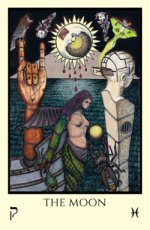Thirteen
Greetings. I'm posting this question in a few of the history forums in hopes of finding an answer. There's a discussion about the Moon in the Using Tarot Cards forum and there is the usual confusion over the assignment of Pisces to that card. It doesn't make sense to new tarot readers that it should be Pisces rather than the Moon (planet) or Cancer (zodiac sign ruled by the Moon). I was wondering if any one could explain when this assignment was made, by whom and the rational behind it. I have asked in the Rider-Waite forum, and the experts there have no solid information. They suggested that the assignment is likely more Golden Dawn or perhaps even farther back than that.
I'd like to find out what I can about this strange assignment, so that I can explain to tarot newbies why the Moon isn't represented by the moon (as the Sun is represented by the sun), or even by a zodiac sign that has, as its planet, the moon. It's represented by a sign affiliated with Neptune.
Another question: Given that the Moon is astrologically Pisces, should the Moon be viewed metaphorically as "the Moon": nighttime illumination, lunar mother-goddess, waxing/waning, running under the moon, etc. OR, should the card really be labeled "nighttime" or "the dreamer"? Isn't the High Priestess, assigned the Moon, more in line with typical Moon tropes? If the Moon card is represented by a zodiac sign which is not directly or indirectly related to the moon (only tangentially in being a water sign), how do we relate it literally/metaphysically/mythologically to the Moon?
Any help would be very much appreciated.
I'd like to find out what I can about this strange assignment, so that I can explain to tarot newbies why the Moon isn't represented by the moon (as the Sun is represented by the sun), or even by a zodiac sign that has, as its planet, the moon. It's represented by a sign affiliated with Neptune.
Another question: Given that the Moon is astrologically Pisces, should the Moon be viewed metaphorically as "the Moon": nighttime illumination, lunar mother-goddess, waxing/waning, running under the moon, etc. OR, should the card really be labeled "nighttime" or "the dreamer"? Isn't the High Priestess, assigned the Moon, more in line with typical Moon tropes? If the Moon card is represented by a zodiac sign which is not directly or indirectly related to the moon (only tangentially in being a water sign), how do we relate it literally/metaphysically/mythologically to the Moon?
Any help would be very much appreciated.




